Alejandro Torres-Sánchez, Max Kerr Winter, Guillaume Salbreux.
Abstract
We introduce a modelling and simulation framework for cell aggregates in three dimensions based on interacting active surfaces. Cell mechanics is captured by a physical description of the acto-myosin cortex that includes cortical flows, viscous forces, active tensions, and bending moments. Cells interact with each other via short-range forces capturing the effect of adhesion molecules. We discretise the model constitutive equations using a finite element method, and provide a parallel implementation in C++. We discuss examples of application of this framework to simulations involving small and medium-sized aggregates: we consider the shape and dynamics of a cell doublet, a planar cell sheet, and a growing cell aggregate. This framework opens the door to the systematic exploration of the cell to tissue-scale mechanics of cell aggregates, which plays a key role in the morphogenesis of embryos and organoids.
Author summary
Understanding how tissue-scale morphogenesis arises from cell mechanics and cell-cell interactions is a fundamental question in developmental biology. Here we propose a mathematical and numerical framework to address this question. In this framework, each cell is described as an active surface representing the cell acto-myosin cortex, subjected to flows and shape changes according to active tensions, and to interaction with neighbouring cells in the tissue. Our method describes cellular processes such as cortical flows, cell adhesion, and cell shape changes in a deforming three-dimensional cellular aggregate. To solve the equations numerically, we employ a finite element discretisation, which allows us to solve for flows and cell shape changes with arbitrary resolution. We discuss applications of our framework to describe cell-cell adhesion in doublets, three-dimensional cell shape in a simple epithelium, and three-dimensional growth of a cell aggregate.
